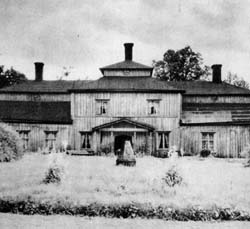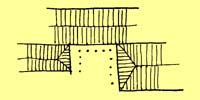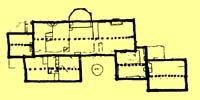
. . . assume now that you have a rough plan, to scale, for each floor of the building. In this case you already know roughly how the roofs will go, from CASCADE OF ROOFS (116) and SHELTERING ROOF (117); and you know exactly where the roof is flat to form roof gardens next to rooms at different floors - ROOF GARDEN (118). This pattern shows you how to get a detailed roof plan for the building, which helps those patterns come to life, for any plan which you have drawn.

What kind of roof plan is organically related to the nature of your building?
Therefore:
Arrange the roofs so that each distinct roof corresponds to an identifiable social entity in the building or building complex. Place the largest roofs - those which are highest and have the largest span - over the largest and most important and most communal spaces; build the lesser roofs off these largest and highest roofs; and build the smallest roofs of all off these lesser roofs, in the form of half-vaults and sheds over alcoves and thick walls.


We know, from arguments presented in THE SHAPE OF INDOOR SPACE (191), that the majority of spaces in an organic building will have roughly - not necessarily perfectly - straight walls because it is only then that the space on both sides of the walls can be positive, or convex in shape.
And we know, from similar arguments, that the majority of the angles in the building will be roughly - again, not exactly - right angles, that is, in the general range of 80 to 100 degrees.
We know, therefore, that the class of natural plans may contain a variety of shapes like half circles, octagons, and so on - but that for the most part, it will be made of very rough, sloppy rectangles.
We also know, from SHELTERING ROOF (117), that entire wings should be under one roof whenever possible and that the building is to be roofed with a mixture of flat roofs and sloping or domical roofs, with the accent on those which are not flat.
We may therefore state the problem of defining a roof layout as follows: Given an arbitrary plan of the type described above, how can we fit to it an arrangement of roofs which conforms to the CASCADE OF ROOFS (116) and SHELTERING ROOF (117) and ROOF GARDENS (118)?
Before explaining the procedure for laying out roofs in detail, we underline five assumptions which provide the basis for the procedure. 1. The "pitched" roofs may actually be pitched, or they may be vaults with a curved pitch, or barrel vaults - as described in ROOF VAULTS (220). The general procedure, in all three cases, is the same. (For curved vaults, define slope as height-to-width ratio.)

The "pitch" of a vaulted roof.
2. Assume that all roofs in the building, which are not flat, have roughly the same slope. For a given climate and roof construction, one slope is usually best; and this greatly simplifies construction.
The same slope throughout.
3. Since all roofs have the same slope, the roofs which cover the widest wings and/or rooms will have the highest peaks; those covering smaller wings and rooms will be relatively lower. This is consistent with MAIN BUILDING (99), CASCADE OF ROOFS (116), and CEILING HEIGHT VARIETY (190).
Wide roofs are highest.
4. Any place where the building helps to enclose an outdoor room or courtyard needs an even eave line so that it has the space of a "room." An irregular roof line, with gable ends, will usually destroy the space of a small courtyard. It is necessary, therefore, that roofs be hipped in these positions to make the roof edge horizontal.
Low roof edge round a courtyard.
5. In all other positions, leave the ends of buildings and wings as gable ends.
One version of a roof layout, using ultra-lightweight concrete vaults as roofs.
We shall now discuss the rules for roofing a building by using an example of a house designed by a layman using the pattern language. This building plan is shown below. It is a single-story house and it contains no roof gardens or balconies.










Treat the smallest shed roofs, which cover thick walls and alcoves, as buttresses, and build them to help take the horizontal thrust from floor vaults and higher roof vaults - THICKENING THE OUTER WALLS (211). . . .